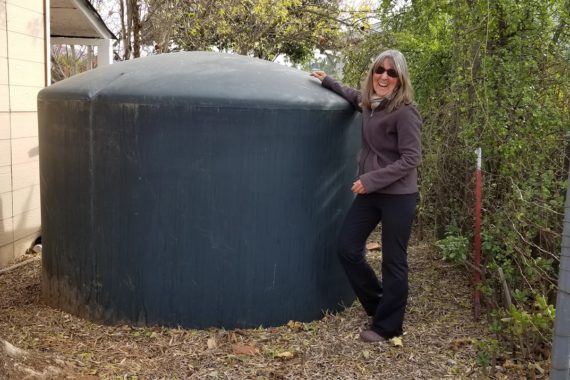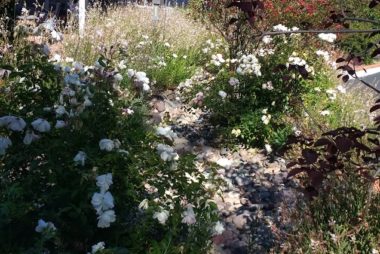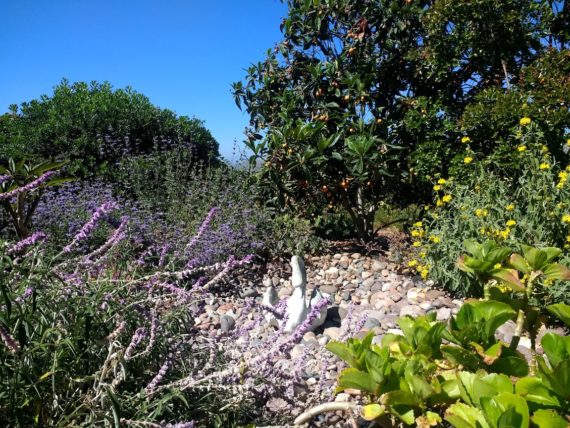Using Water Wisely
 It all started with a drip drip drip off the patio roof. University of California (UC) Master Gardener Pam Kirpalani put a pan from the kitchen out to save the water from that drip. Soon the pan was full and she switched to catching the drip in clean trash cans. When those were full, she invested in rain barrels fed by gutters from the roof. Seven years later, Kirpalani has invested in tanks that can hold over 2300 gallons of rainwater. The tanks typically provide enough water to irrigate her 14 fruit trees through July. With this year’s unusually heavy rains the tanks have been filled, emptied onto the orchard, and filled again. Kirpalani estimates that this year the water will last through August. She uses a soil moisture meter to determine when to irrigate. No city water has been used on the 1.6-acre property since December.
It all started with a drip drip drip off the patio roof. University of California (UC) Master Gardener Pam Kirpalani put a pan from the kitchen out to save the water from that drip. Soon the pan was full and she switched to catching the drip in clean trash cans. When those were full, she invested in rain barrels fed by gutters from the roof. Seven years later, Kirpalani has invested in tanks that can hold over 2300 gallons of rainwater. The tanks typically provide enough water to irrigate her 14 fruit trees through July. With this year’s unusually heavy rains the tanks have been filled, emptied onto the orchard, and filled again. Kirpalani estimates that this year the water will last through August. She uses a soil moisture meter to determine when to irrigate. No city water has been used on the 1.6-acre property since December.
However, even a 2300-gallon tank is not enough to capture all the rainwater that runs off the roof during even a typical season. To capture more water, the front yard has been graded to include a swale, a shallow channel with gently sloping sides. The swale is designed to slow and capture runoff; it is lined with rocks to prevent erosion. Downspouts direct rainwater from the roof into the swale to soak into the soil rather than running down the driveway and into the street. Kirpalani’s swale is landscaped with plants that are adaptable to either wet or dry conditions. Waterwise plants fill the rest of the property; the lawn was removed years ago to make way for more plants.
Other methods for conserving water can be found at UC Master Gardener Robert Lawson’s home.
 At first glance you might not think that Lawson’s avocado, citrus and stone fruit trees have a “secret weapon” to allow them to flourish by conserving rainwater. The trees are planted in an ordinary looking bed, but if you could look under the mulch you would see that the trees are planted next to trenches that serve as collection basins for rainwater. Gutters direct rainwater from the roof into the trenches to allow it to slowly soak into the soil. The trenches are fitted with popup drains in case of overflow and are topped with gorilla hair (coconut husk fiber) mulch. Plants and trees grow better with rainwater than tap water because tap water contains salt. Excess salt is harmful to soil structure and plant growth.
At first glance you might not think that Lawson’s avocado, citrus and stone fruit trees have a “secret weapon” to allow them to flourish by conserving rainwater. The trees are planted in an ordinary looking bed, but if you could look under the mulch you would see that the trees are planted next to trenches that serve as collection basins for rainwater. Gutters direct rainwater from the roof into the trenches to allow it to slowly soak into the soil. The trenches are fitted with popup drains in case of overflow and are topped with gorilla hair (coconut husk fiber) mulch. Plants and trees grow better with rainwater than tap water because tap water contains salt. Excess salt is harmful to soil structure and plant growth.
In addition to the collection basins, the Lawsons save rainwater in a 1,000-gallon system. Lawson supplements the irrigation of their 20 fruit trees with 10 gallons of saved rainwater per tree per month to help move salt in the soil below the root zone.

The Lawsons also use graywater to irrigate the stone fruit trees. Graywater is water re-used from bathroom sinks, showers, tubs and washing machines but not water from toilets, kitchen sinks, dishwashers or from washing dirty diapers. Graywater may contain traces of dirt, food, grease, hair and certain household cleaning products. Graywater may look “dirty,” but for most plants it is a safe and beneficial source of irrigation water.
Besides using rainwater and gray water, the Lawsons conserve water by having a smaller lawn. When they bought their house in 2017 both front and backyards were landscaped with high-water-use grass. By 2018 the lawn had been reduced by over 90% and native plants and fruit trees had been planted. By irrigating with rainwater and graywater their water bill dropped by more than 45% - even though San Diego had very little rain last year. Lawson says, “What I really like is that our household overall usage is now just 51 gallons per person per day!”
Both Kirpalani’s and Lawson’s gardens are certified as Earth-Friendly. You can learn more about Earth-Friendly gardening and evaluate how you are doing using our idea filled checklist, available at https://www.mastergardenersd.org/. Click on the Earth-Friendly Garden sign. As a reward for your efforts and to support our non-profit county-wide program, you can purchase an Earth-Friendly Garden yard sign. It is a great way to share with visitors that your garden is sustainable and is a conversation starter about Earth-Friendly gardening.
Notes – graywater must not touch edible parts of plants or be used for lawn irrigation. It should not be allowed to contaminate natural bodies of water - its nutrients could become pollutants. To learn more, see https://www.sdcwa.org/sites/default/files/graywater_guidelines.pdf and https://www.gardenmyths.com/gray-water-safe-garden/
Rain barrels must be tightly screened to prevent mosquito breeding. See http://ipm.ucanr.edu/QT/mosquitocard.html and https://www.glacvcd.org/2016/01/how-keep-mosquitoes-out-of-rain-barrels/
If you have questions, visit us at the Earth-Friendly booth during our Fall Garden Tour on September 28th. https://www.mastergardenersd.org/fall-garden-tour/ You can also call the Master Gardener "Hotline" (858) 822-6910, or visit our website at https://www.mastergardenersd.org/.
Dawn Standke has been a UCCE Master Gardener volunteer since 2005

